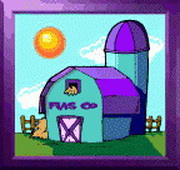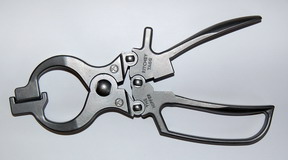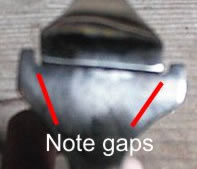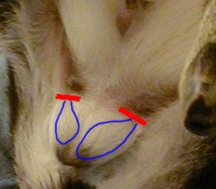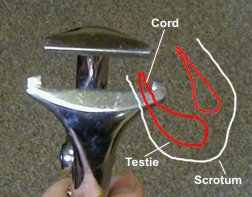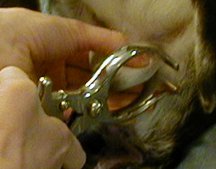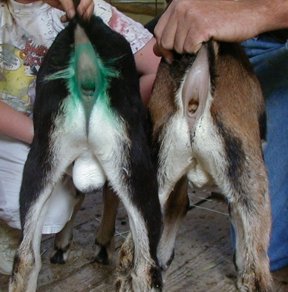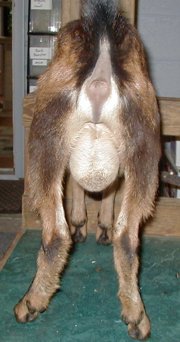Male Goat Information:
Bucks & Wethers
First and foremost let me start by saying PLEASE, DO NOT let your buck(s) and does live together. If you do, you will have no control over breeding and will have no idea when to expect kids. Because of this you will be unable to give the doe proper prenatal care and also will have no idea when she is due to kid. You will be unable to prepare and you will risk loosing babies. Our bucks and does live very happy, separate lives, and only meet each other when we take them on "dates".

A goat kid of either sex can be fertile at 7 weeks of age (though they should not be bred at that age). Intact bucks and does over 8 weeks of age should not be kept together because a young buck can, and will,breed a female at 2 months of age, this includes his mother and 2 month old sister!
Terms:
Buck: Male
Goat
Buckling: "Teenage"
male goat
Wether: Neutered male
Index of the information you will find on this page:
- Keeping a buck or wether
- Buck behavior
- "Should
I keep him a buck or wether him" and "Should I buy
that buck" Q&A:
- When do a really need to get a buck?
- Reasons to keep/buy a buck.
- Where will you keep your buck?
- Do you want papers?
- Should you get more than one?
- Breeding:
- What age can a buck breed?
- At what age should I remove the buckling from the does?
- Neutering:
Also read:
- Breeding Information
- Urinary Stones - If you have a male goat, you need to read over this information.
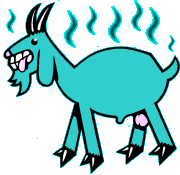
"Nanny" & "Billy": In an effort to rid the much maligned goat of the stereotype of the tin can eating nanny, and the "mean" billy, many registry associations & breeders, including us, use the terms "doe" instead of nanny and "buck" instead of billy. It is considered polite to the breeders and respectful of the goat to use the doe and buck terms.
Keeping a buck or wether:
Often, people just starting out with goats think, "I should get a pair: a boy and girl". This is a natural way to think. But... bucks are totally different than does and are really not a good thing to get for someone first starting out (see below for more detailed information). I raised goats for about four years before I got my quality bucks. I started out with an inferior buck (please read My First Goat), realized my mistake, got rid of him and then didn't get bucks again for 4 years. I speak from experience, it is much easier... and cheaper to take your does on "dates". Even if you think you are not interested in "papers" and "breeds", I always recommend that you try to "breed up". Use a good buck, with good genetics, that will improve your herd.
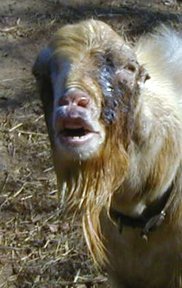
During rut, our snow white buck, Galahad, becomes coated in sticky, smelly urine.
Remember:"The buck is half your herd". A bad buck can ruin your herd just as fast as a good buck can improve it. Just because he has "the equipment" does not mean he should be used for breeding. When you are ready to get a buck, you must be fully prepared to spend in the neighborhood of $300 or more on a good buck with papers. Some other breeders may also, sell quality bucks without papers for a greatly reduced price. This means you still get the quality genetics, but you cannot register the babies. You may occasionally find a quality buck without papers from other souses, but you must be very careful to know what you are really getting. You want to make sure you see at least the buck's mother, and possibly the father, of any buck you decide on. Look at the mothers udder, because is she has a "bad" udder, those udder genes will be passed on through her son and you really do not want that.
I made the mistake of using just any-ol'-buck our first year with goats and have regretted it even since. It took years (I mean years) to breed out the bad genes that buck passed to his offspring (children, grandchildren, great grandchildren). After years of trying to improve on this original breeding, I actually have none of this first buck's blood in my herd because we ended up selling all his progeny since they just were never "as good" as the other kids we got when we bred the same doe to good bucks. Some of his progeny just carried out-and-out flaws that we could never breed out.
It is much cheaper to take your does on "dates". You can vastly improve your herd for a lot less money. Look for a quality buck from a reputable breeder. You could probably find a wonderful buck with a stud fee of about $25. Look around for a good buck and use him. You will be glad you did. If you have the money to invest (it really is an investment in the future of your herd) you could make great leaps forward in your herd. For example, you may be able to breed your doe to a "$1000 buck" for the stud fee of $50-$75.
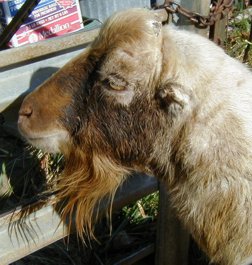 This buck's normally white face has become stained by urine. The darker area is a sticky crust. |
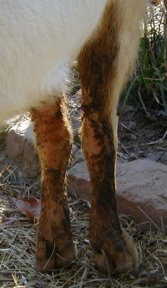 Front legs encrusted with urine. This can lead to irritated skin and sores. |
I don't recommend keeping a bucks as a pet because of their bucky characteristics. Wethers make excellent pets, but in my own opinion, bucks do not. This is because wethers never develop "bucky" characteristics. Bucks are totally different animals than wethers and does. It may be hard for you to believe that your cute little buckling will change, but take my word for it, he will.
If you decide to keep a buck as a pet, that is your decision, but please read the information supplied below first and be prepared. I provide this information because I truly CARE about bucks (as I care deeply for all animals). I know that in some cases of a buck being kept as a pet, he may eventually become unwanted because of his bucky characteristics, that his owner had no idea about. He may then be "discarded" and this poor, loving boy, gets taken to the auction and/or eventually getting "tied out" alone somewhere to live a lonely sad life. This is a scenario I would like to help avoid.
What are the "bucky" characteristics?
Smell:
As your buck grows he will develop a distinctive odor. Many people
find it a bad smell, others don't find it that bad, they just
find it strong. The odor will not be quite so bad the first year,
and you may say, "This isn't so bad. My buck is not going
to smell so much." But as he gets older, the smell will strengthen
and eventually you may not want to touch your buck, because the
smell will get on your hands and clothes (and everything else).
A drawback to this is a friendly buck will want you to pet him
and you will get the smell on you. I have gotten used to it,
but you will definitely want to wash your hands and change clothes
before going out in public after petting your buck.
Does and wethers (neutered males) do not develop a smell like bucks do. It is bucks and their smell that have given all goats a "bad rap" for smelling. If you keep your buck with your does (not recommended) the buck smell will get on the does, and if you milk the does, it can get in their milk.
Urinating:
As bucks mature and go into rut, the male equivalent of heat (in
the Fall), they will start peeing on their front legs and faces.
They have a kind of "spray attachment" on the penis
and can really spray. He will spray his urine into his mouth and
then curl up his lip to get a good whiff. His legs, face and beard
will eventually be coated with a sticky layer of urine (irresistible
to a doe). Once rut is over (in the Winter) he may, or may not,
stop peeing on himself.
One drawback to this urinating is that if you spend time around the buck when he is in this habit, you could possibly get sprayed on as well (time to change your clothes again).
Aggression:
As a buck matures, he will get more aggressive. This is natural.
Even the sweetest, most well behaved buck may challenge you, as
well as his companions, from time to time (usually during breeding
season). The larger the buck grows, the more dangerous this can
potentially be. You must always make sure that your buck knows
that you are boss as early as possible. A wether will not typically
develop the aggression of a buck. Note that not all bucks become
dangerously aggressive. I have only had one dangerous buck. Mostly
our boys are just extremely stinky sweethearts, who would not
think of hurting us (on purpose) but we still treat them with
caution and respect during rut.
Other
habits:
As he goes into rut, your buck will want to make sure all his
equipment is in proper working order, so he will be ready at a
moment's notice to breed a doe. He will get erections quite often.
He will check himself with his mouth (yes, he will be able to
reach).
A buck will practice his sexual technique on his male companions. He may also try to practice on you if you are not careful. He may not intend to hurt you, but you should be very careful when you are around a buck in rut.
Please also read about buck behavior here.
 Spraying urine on his face and legs |
 Taking a good whiff after peeing on his face. |
If you have the space, are physically capable of handling them, and do not mind "their funky ways" bucks can be quite amusing. I love my bucks very much. They are great, friendly and funny, but I also have 20 does to be serviced, so keeping bucks (I have three) makes financial sense.
Bucks have their own special way of getting the ladies in the mood. Along with their smell and peeing habits (discussed above) they also have some certain behaviors that may seem odd, especially if you have never seen it before. These mannerisms are most often exhibited toward the doe in heat, but because breeding and dominance can be so closely related, you will also see does and wethers, as well as bucks asserting their dominance over each other (or you) by exhibiting these traits. Also, does in heat will exhibit these traits and we call this "acting bucky".
These mannerisms are totally normal and the buck may try them on you as well as a doe. When a buck is "in the mood" he doesn't always care what sex or species he tries to breed. If a buck exhibits these traits at you, he may have a crush on you and you should be careful that he doesn't try to mount you when you aren't looking.
- Tongue flapping- The buck will lower his head and flap his tongue at the side of the doe (or you).
- Leg pawing - The buck paws at the side of the doe with a straightened leg. This is usually done at the same time as tongue flapping.
- Blubbering- This is done toward the doe (or you); it can can be done in conjunction with leg pawing and tongue flapping.
"Should I keep him a buck or wether him" and "Should I buy that buck" Q&A:
When do a really need to get a buck?I recommend, for most cases, that you hold off on getting your own buck until you have at least 6 does (depending on your particular situation, of course). Generally, this is really the only time a buck really approaches paying for himself. Remember, most of the year, he is doing nothing but eating and taking up space, but you still must properly feed him, house him and take care of all his health needs. This can add up to a lot of time and money. For the first couple of my goat keeping years I would drive as far as two hours, one way, over the mountains, to breed my does. This was more cost effective at the time than actually having my own buck. But, as my herd grew, it because obvious when it was time for me to get my own bucks (I started with two).Just because he has a penis is not a good enough reason to keep/buy a buck.
As stated above: "The buck is half your herd". You are basing the future of your herd on this animal. You need to consider, will he improve your herd or will he have a negative effect. Just making more kids is not enough. If you are going to keep goats... any kind of goats, with papers or no papers, there is no reason why you shouldn't try to improve them. To improve your herd, you need a quality buck.Where will you keep your buck?
IMPORTANT: I very strongly recommend that bucks be housed separate from your does. This is the only way you can have control over your breeding. If you "run" the buck with the does, you will have no idea when your does are going to kid. Due to this, you will not be prepared for kidding and you run the risk of loosing the kids, because you were not their the assist if needed. When you house the buck away from the does, you must provide a companion for him, this can be either another buck or a wether. Goats are herd animals and it is cruel to keep one alone. Keeping a lone buck can also lead to "cranky buck syndrome".Do you want papers?
Many people do not care whether their buck is registered or not. This is a personal choice. The first year I kept a buck, I did not worry about a buck having papers, and I have regretted it ever since. Keep in mind, it takes just as much time and money to raise a registered goat as a non-registered goat, the big difference is the price you will get for them when you go to sell them. You just cannot ask for, and expect to get, top dollar for a goat without papers. Please read the information presented HERE.Should you get more than one?
It sound extravagant, but to avoid Inbreeding, if you are going to keep one buck, you should conceder getting two bucks (since the one will need company anyway). This way you are not forced to keep breeding the same buck to all your does every year.How to choose a buck to breed your does to:
Please read the information presented HERE.
What age can a buck breed?
Believe it or not, a little buck can, and will, breed a female at 2 months of age, this includes his mother and 2 month old sister!
If you plan to use a buckling for breeding, I recommend that you weight until he is at least 7 months old to make sure he is fertile and healthy enough to accomplish his task.
At what age should I remove the buckling from the does?
You should remove bucks from all does at two months of age (unless you want everyone to get pregnant in a totally disorganized manner).
It
is common practice to postpone neutering as long as possible to allow
the wether's urethra to grow as a prevention measure against "stones".
I neuter my male kids at 4 weeks of age. I never neuter earlier than three weeks of age.
Please read the information
provided here: Urinary
Stones.
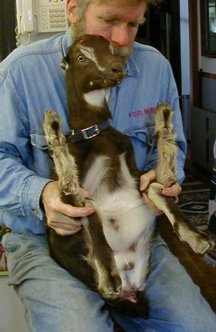
How to restrain the kid for neutering:
The kid is held by an assistant who holds the kid in his lap. The assistant should grasps the kid's hind and front legs of the same side with each hand. The kid will be in a human-like "sitting" position with it's back to the assistant and his butt is cradled in the assistants thighs.
There
are three ways of neutering a buckling:
"Cutting", "Banding" and using a "Burdizzo".
This entails cutting the bottom of the scrotum off and pulling out the testicles.
Pros: Most reliable method; Inexpensive.
Cons: Cutting the scrotum opens the door to infection and tetanus. Definitely not for the squeamish
Notes: Kids with a scrotal hernia should not be castrated by the cutting method. Care should be taken not to excite kids before or immediately after castration.
Materials needed: A sharp knife or scalpel, soap and water, disinfectant, syringes and tetanus antitoxin.
Age of kid: Any time after the testicles descend.
Note: Extreme care must be taken when "cutting" older bucks because of the possibility of bleeding to death. Bucks over month old should be "cut" only by a vet, or experienced breeder, while under anesthesia.
Technique:
- I recommend you administer something to help with pain. This is the humane thing to do to help the kid deal with the pain of the procedure. You could use:
- Banamine - give the kid a shot 1/2 hour before you neuter. It will also aid in reducing swelling as well as makes the kid just a little easier to hold. - OR -
- Ow-ese Herbal Tincture - aids with stress and well as pain and inflammation. Give about 1/2 - 1 hour before procedure.
- Begin by washing your hands and instruments thoroughly with soap and water and then disinfectant. Wash the scrotum and disinfect.
- Restrain the kid (see photo).
- Push the testes up out of the way and cut off the lower 1/3 of the scrotum with a cut parallel to the ground. The testes should now be visible.
- Using your fingers, grasp one of the testis and pull downward. The testes are very slick and difficult to hold onto, so grasp firmly. Do not to allow the testis or spermatic cord to go back up into the scrotum once you have touched it as this will increase chances of infection.
a. In young kids (less than 4 or 5 weeks) pull down firmly, but steadily until the cord breaks. In older kids or adults, instead of pulling the cord, use the knife or scalpel to sever the cord. Do not cut the cord cleanly, instead scrape it until it abrades through. Because the spermatic cord contains many blood vessels, a clean cut could cause excessive blood loss.- If a segment of the spermatic cord is protruding below the cut scrotum, it must be removed. If left exposed, it will act as a wick to pull bacteria into the body cavity and cause infection. Pull it free or abrade it with the knife.
- Apply antiseptic to the castration site and administer an injection of tetanus antitoxin.
This entails using a tool called an elastrator to put special heavy duty little rubber bands around the scrotum leading to the testicles. The blood circulation stops and in about 10 to 14 days, the scrotum and testes will slough off. (In laymen's terms: the scrotum and testes die, rot and eventually fall off).
Pros: Inexpensive
Cons: Least humane way of neutering; faulty castration technique results in retention of one testicle. Risk of tetanus.
Notes: Some European countries have banned elastic band castration because officials consider it's use inhumane.
I personally I feel banding is extremely inhumane. I strongly urge people to have compassion for the animal and not to use this method. Imagine putting a rubber band around your finger and then leaving it there until your finger fell off. Now imagine putting a rubber band around you own testicles and leaving it there until your tentacles died, rotted and fell off. Animals feel just as much pain as you would, and it is just as traumatic for them as it would be for you.
Materials needed: Elastrator (instrument used to apply the bands), Castrating bands or rings (Do not use household rubber bands!) and tetanus antitoxin.
Age of kid: Any time after the testicles descend.
Technique: .....Note: I provide as much information on this site as possible so that people can make their own choices about how they wish to raise their own animals. But, I have come to the conclusion that I feel banding is so wrong and I am no longer going to provide the instructions on how to do it here on my site. I am a strong advocate of animals rights and of the compassionate treatment of all living creatures and I cannot bare the thought that information I provided would cause a living creature so much suffering. Just because it is inexpensive and relatively easy to do for the human, does not justify it as a right way to treat an animal.
Burdizzo (aka: Emasculatome; variation: Ritchey Nipper):
(This is the method I use to neuter.)
The emasculatome , Burdizzo or Ritchey Nipper, method involves a clamp-like tool which crushes the spermatic cord and blood vessels leading to the testicles. The effect is to prevent blood reaching the testicles so that they gradually wither away and die. This method is known as a "bloodless" method since no cutting is done and when done properly the skin is not even broken. Care must be taken to be sure that both cords have been properly crushed. It is quick, and while it is not painless, the kid is up and moving with the herd right away (though he may "mince" a little). The kid is totally recovered by the next day, though there will be some swelling. I have been extremely successful using this tool, but you should check the testicles in about 3-4 weeks to make sure they are no longer growing. The wether will always have his scrotum (I call it his "souvenir"), but his testicles will stop growing, and eventually disappear. After 4 weeks the testicles should be very small and hard. If they are the same size or bigger than they were when you neutered him, you must reneuter.
Pros: Quick recovery; No chance of infection or tetanus since there is no cutting or blood involved; Relatively humane as these things go.
Cons: The tool can be expensive but you can find a good price if you shop around ($39-$107) - This is a precision surgical instrument; hence the higher cost.
Age of kid: 4 weeks - 4 months or even older. I neuter at 4 weeks of age.
Notes: Make sure to check the kid in a about 3-4 weeks after the procedure to make sure he has been properly neutered. The testicles should be firmer and not any bigger than they were when you neutered. By 8 weeks, if he was neutered at 4 weeks of age, the testicles should be small and hard. If you feel a large testicle, he will have to be re-castrated. The longer you wait to neuter (the older the kid is); the longer it will take for the testicles to get smaller. The most important thing to look for is that they are not getting any bigger.
Materials needed:9" Burdizzo (small)/ Emasculatome - Note: There are two to three sizes of this tool, you want the small one (9"). The smaller size is a "one handed" instrument that can be used for all ages (and breeds) of goats and also young calves. You can use the small tool to do adult goats. The larger size tool (14"-18") is for older calves and cattle, must be used with two hands, and is too big to use properly on goats.
Ritchey Nipper / Side Crusher - There is also a slightly differently designed version of this tool called the Ritchey Nipper. I have this tool as well and it works quite well. This biggest problem is that it seems to hard to find.
I received this feedback from a person who uses the Ritchey Nipper:
"After a couple of years use now we have found the Ritchey Nipper to work very well in neutering baby Nigerians and we leave them intact until 6-8 weeks - a lot longer than we would leave a full-size buckling. But we do find even with banamine that it is several weeks - sometimes a couple of months even - before you can really tell that it worked. So if people are checking after two three weeks they may panic and redo the nipping when it isn't necessary. Just our experience."
Note: There are two to three sizes of this tool, you want the small one (9"). The smaller size is a "one handed" instrument designed for use on young calves and so can be adapted for used for all ages (and breeds) of goats. You can use the small tool to do adult goats. The larger size tool (14"-18") is for older calves and cattle, must be used with two hands, and is too big to use properly on goats of age age or size. |
This slightly differently designed tool is called the Ritchey Nipper or Side Crusher. It is more expensive than the Burdizzo, but is designed for use on sheep and goats (as opposed to really being intended to be used on cows) . After trying it out on a couple of my own wethers I decided it was worth the extra money and purchased one for our own use, even though I already had a Burdizzo. I found it a little easier to use and a bit more "sure". |
|
You should be aware that the Burdizzo and Emasculatome are tools actually designed for use on calves and cattle, who are much, much, larger than young goats. We, as goatkeepers, adapt these tools for use on goats, and care must be taken with their use. On the other hand, the Ritchey Nipper/Side Crusher is designed specifically for use on lambs, which are more the same size as kids. Please note: I have been contacted by various people who have had unsuccessful neuterings of their young goat kids using the burdizzo tool. It turns out the reason for their problems stem from variances in the design of this tool (remember, these tool are designed to be used on larger animals). The people were having unsuccessful neuterings using the style of tool that contains gaps on the edges because the small cord on young goats can slip into the gap and thus it not get crunched properly. I have no personal experience using this gap edged tool. I use a tool that has no gaps and my instructions on this page are written using a "gapless" style tool (I place the cord right against the "tooth" of the tool). I have been notified by the legal department of the manufacturer that the "gap" style tool is not defective in any way, but designed this way (for use on calves and cattle) to prevent injury due to skin pinching. So, all I can say is, be sure that if you are using the "gap" style tool, especially on young goat kids, to follow the manufacturer's and/or your veterinarian's instructions and make sure the cord does not slip into the gap. |
|
Technique: NOTE: You DO NOT clamp [once] all the way across the scrotum. I cannot stress that enough. You clamp [twice] a little of each site. Follow the instructions below: 1. I recommend you administer something to help with pain. This is the humane thing to do to help the kid deal with the pain of the procedure. You could use:
2. Restrain the kid (see photo). |
||
|
3. Grasp the scrotum in one hand and manipulate until you have the testes down into the scrotum and the spermatic cord between your fingers. Manipulate the right cord as far to the right side of the scrotum as possible. When you use the burdizzo, you want to "crunch" as little of the scrotum as possible. You apply the burdizzo just below the teats, but be careful not the catch the teats in the tool. 4. Open the the Burdizzo and hold it so that the "C" side (or "toothed side"- two teeth at either end of the "mouth") of the jaw is facing up. Place the left side of the jaws of the Burdizzo over the upper right side scrotum (do not clamp yet), just below the rudimentary teats. Position the jaws/scrotum/cord so that the cord rests on the lower "C" side of the tool. The cord should rest just beside the "tooth" of the tool. but just a little away so that it is fully crushed and none of the cord "falls" into the gap (if your tool has a gap). Only a small amount of the scrotum will be resting on the tool (about 3/8" or so ). It is important that you "clamp" as little of the scrotum as possible, but make sure that the cord is thoroughly crushed. The "tooth" will make sure the cord does not slip out of the tool. 5. When the Burdizzo is properly placed in position (make sure not to clamp the teats). Tell the person holding the kid you are ready (so he can hold tightly) and squeeze the Burdizzo totally closed, clamping it on the kid's scrotum (it will click). This crushes the cord. (At this point the kid will yell bloody murder- wouldn't you?) |
|
|
6. Leave Burdizzo in place a medium count of "five" (about 5-7 seconds) 7. Open the Burdizzo, catch your breath, and repeat on the left side. 8. Gently apply some Aches N' Painz Salve (from Molly's Herbals) to the crunched area and carefully take the kid to his mother or sibling for some moral support. 9. In about 3 weeks, check to make sure the neutering has "taken". You should feel that the testicles have not grown and are actually a little bit smaller than when you neutered. If the testicles are bigger, or one is bigger than the other, you need to reuse the Burdizzo on the bigger testicle cord. If one testicle is smaller, you do not have to redo the small one. Note: the longer you wait to neuter (the older the kid is); the longer it will take for the testicles to get smaller. The most important thing to look for is that they are not getting any bigger. |
|
|
I took this photo to aid people who worry that the burdizo neutering "took". Goats get very large testicles, but unless you've seen how big they actually get, you may mistake the "souvenir" (empty sack) for an unsuccessful neutering. These two kids are brothers that are exactly 2 months old in this photo. The one on the left is an intact buck with normal sized balls for a two months old intact male goat. The kid on the right was neutered when he was three weeks old and has an empty little sack. Note: The green all over the buck's tail is from him being tattooed. He is a registered buck and is about to leave for his new home where he will be a herd sire. |
|
|
Pardon the frankness of these photos, but I thought it would be helpful to you to see what unneutered, fully intact and functioning males look like so you can compare and tell it your neutering was successful. The photo to the right is of a normal 5 month old buck. You can see that goats have quite large testicles. Knowing what an unneutered buck looks like should help you determine it your wether is really a wether. |
